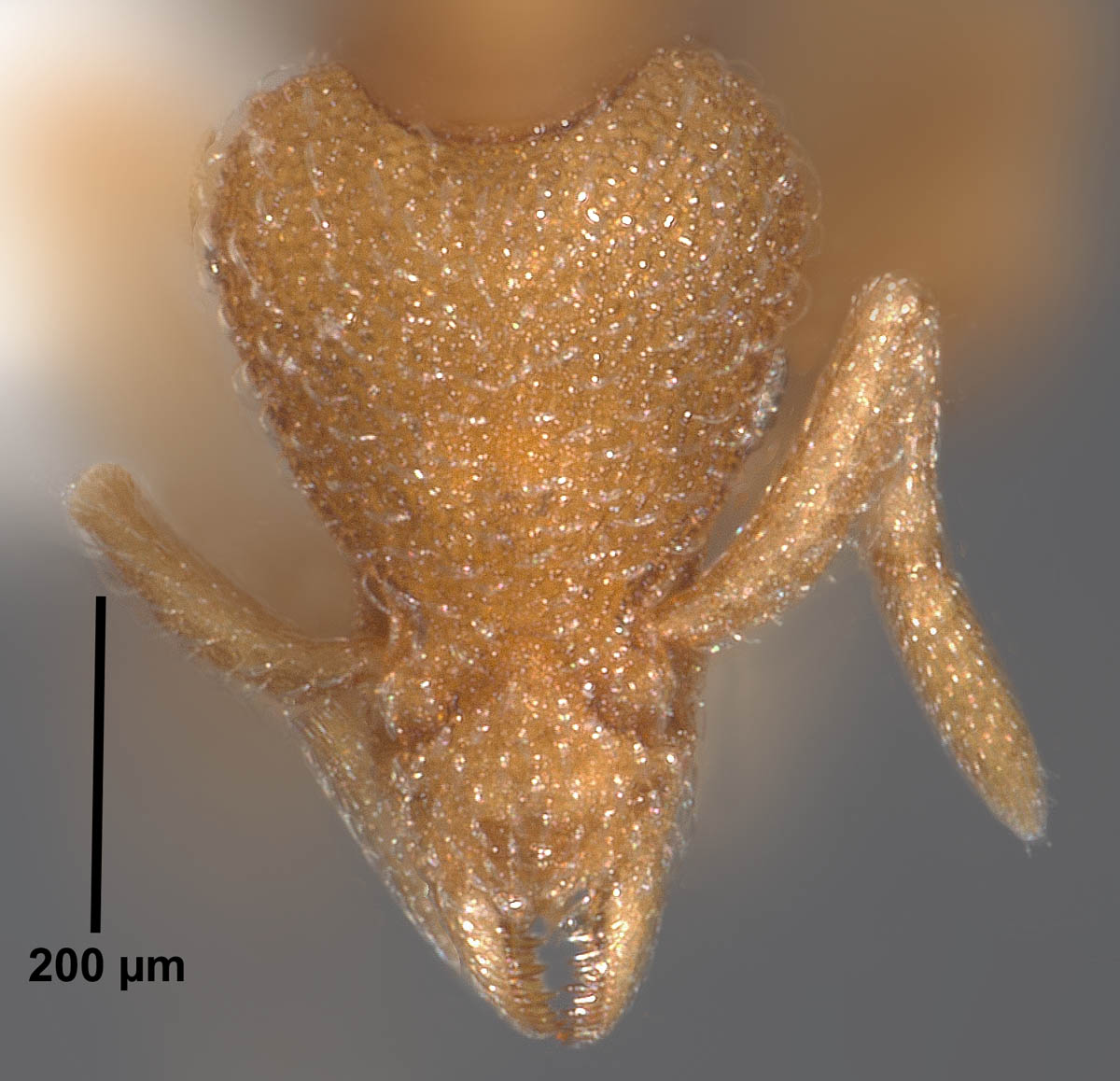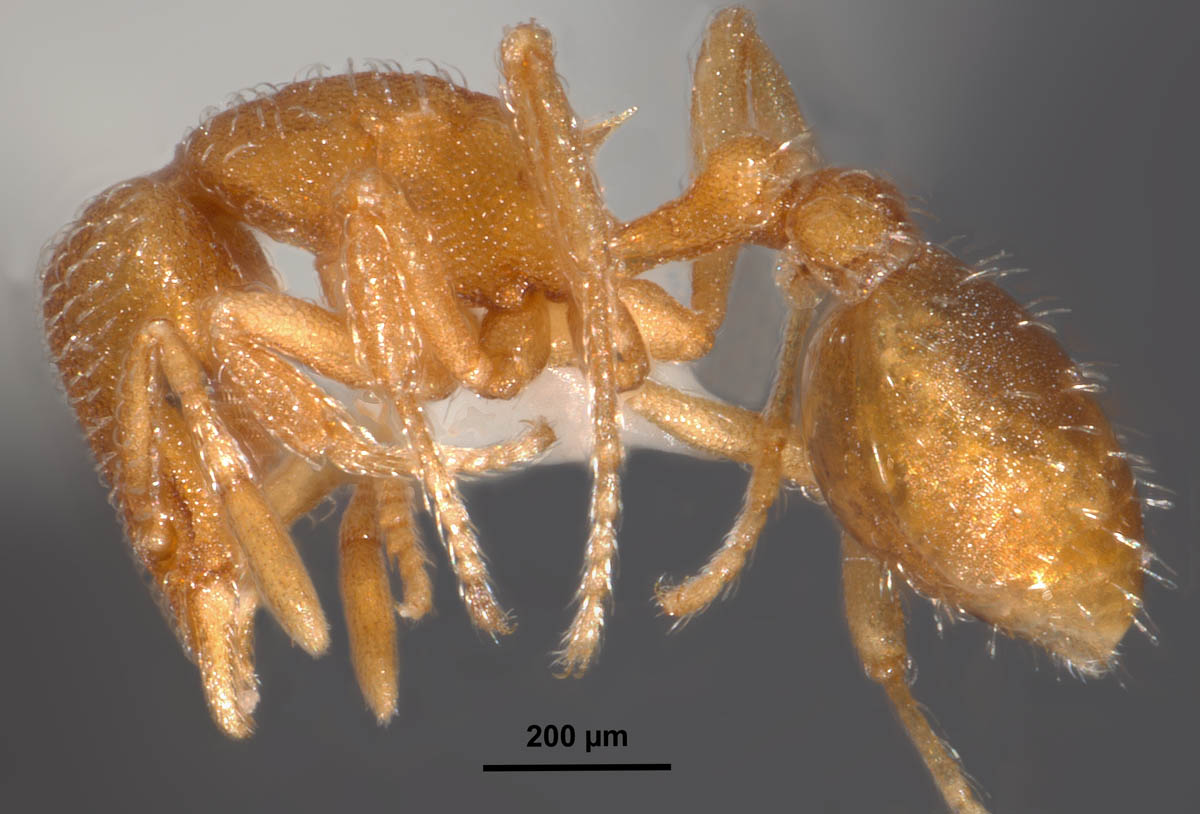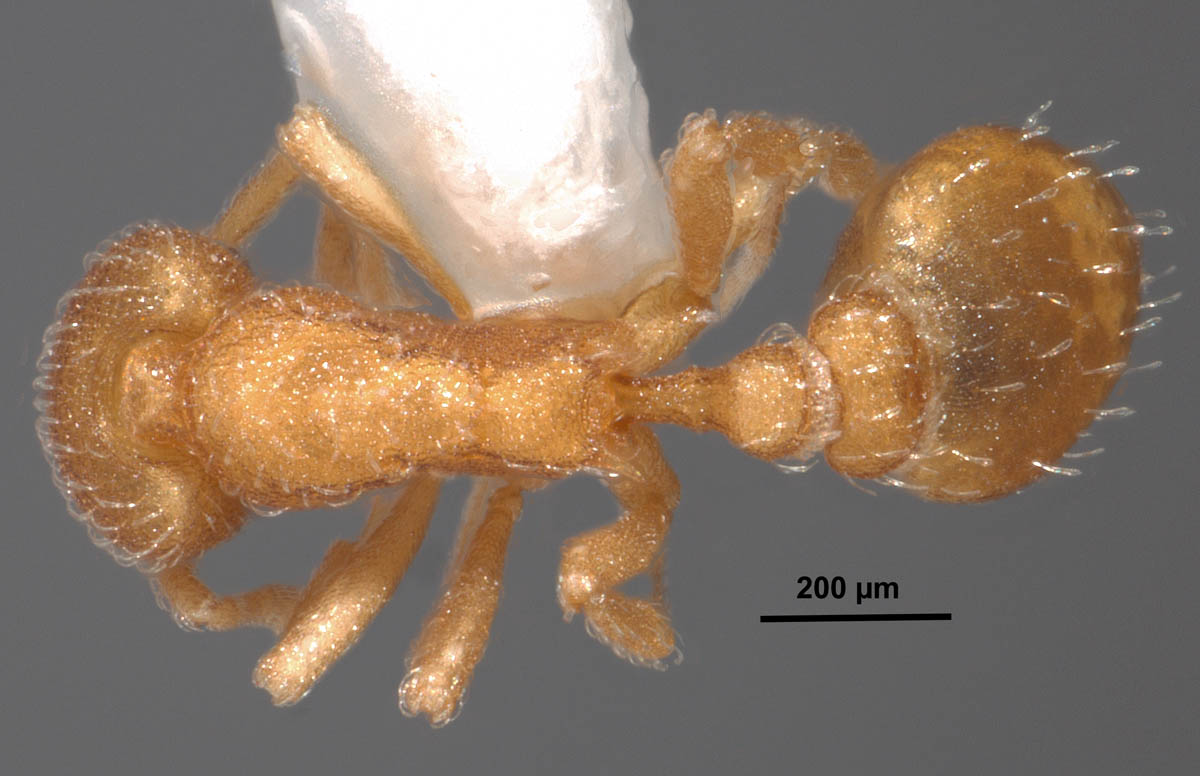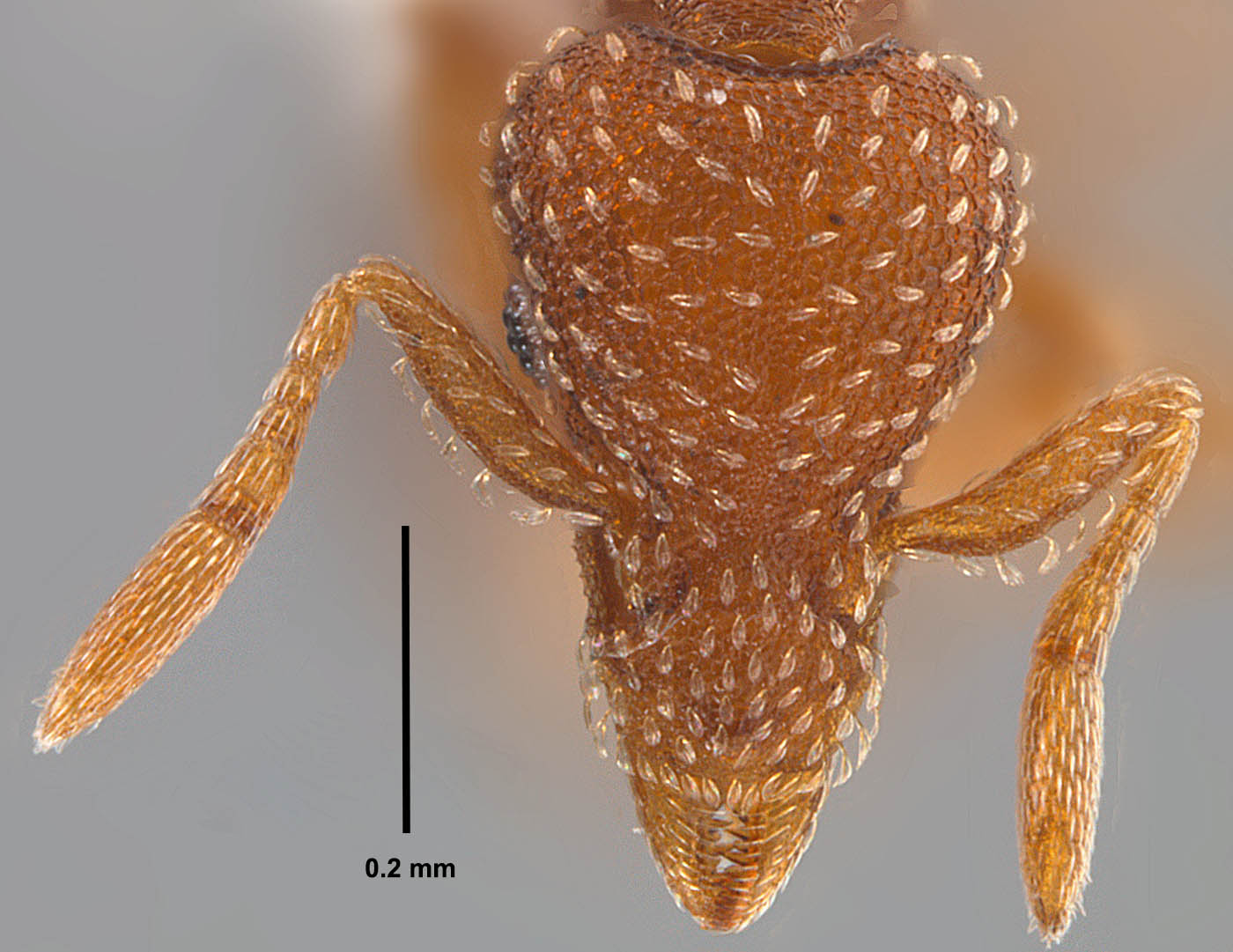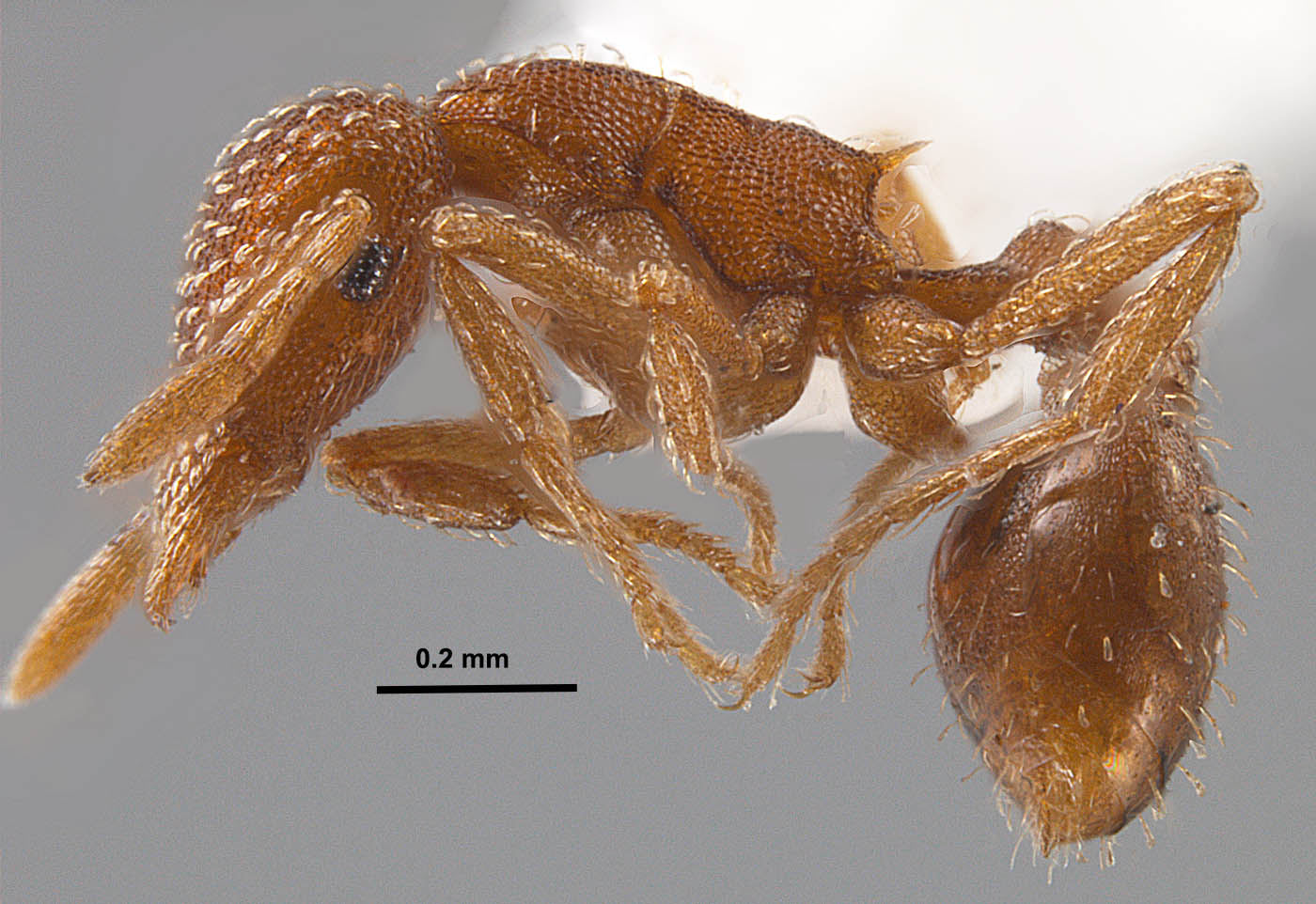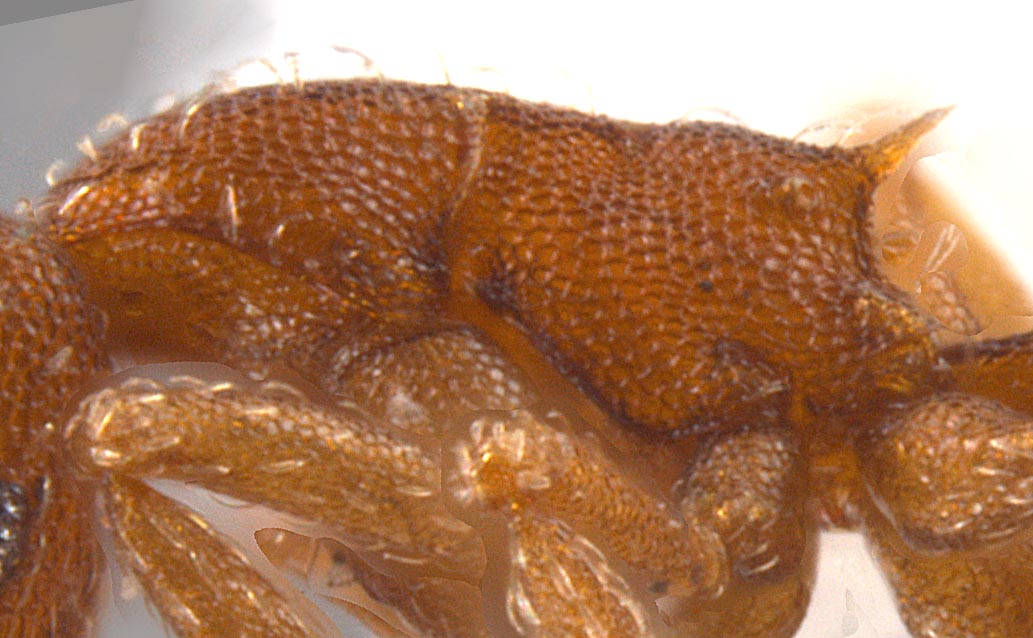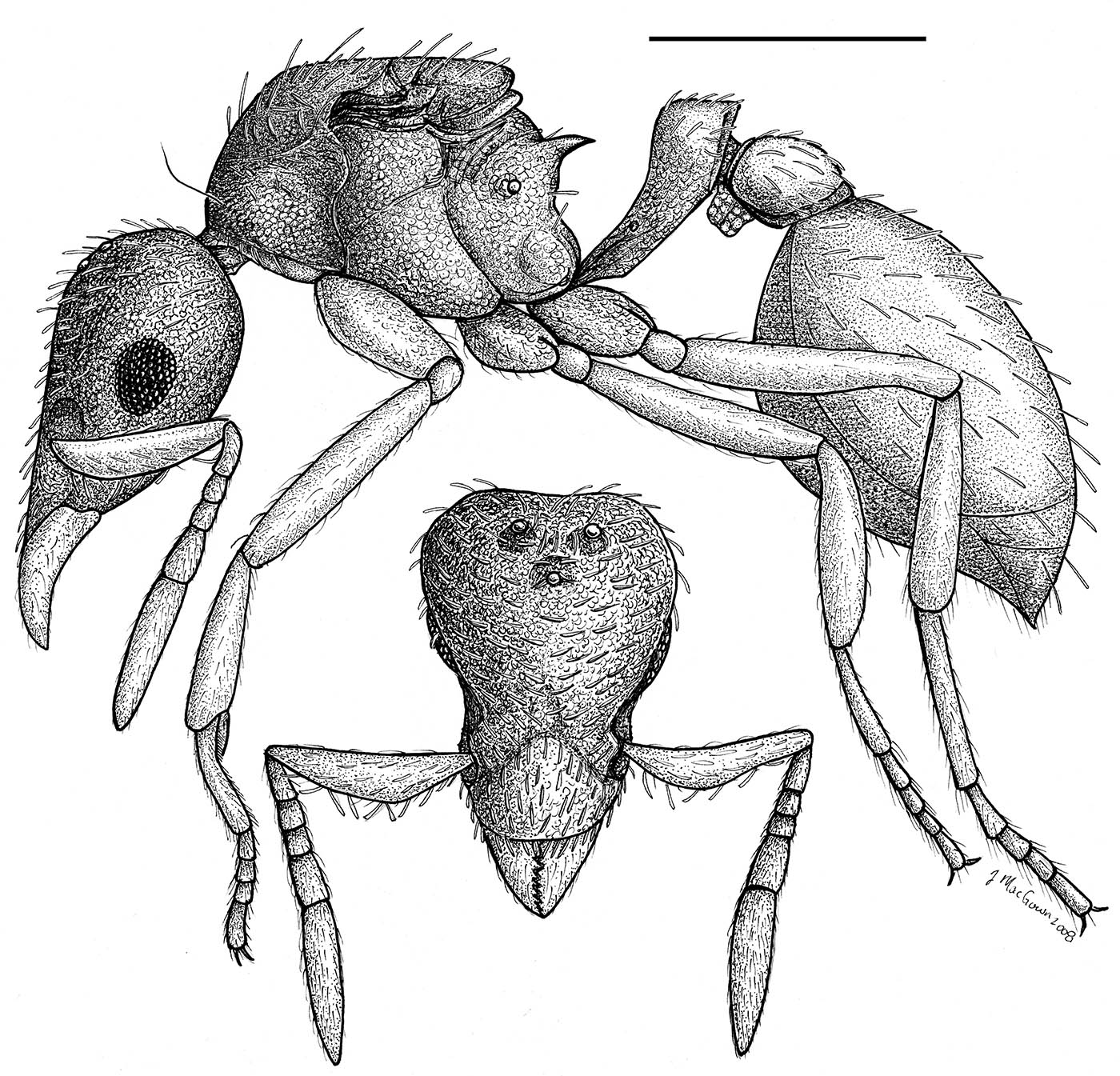Introduction
Strumigenys is a monophyletic genus of attine ants that includes over 900 species worldwide (Bolton 2013). Forty-eight described species of Strumigenys have been reported from the US (Bolton 2013), being most speciose in the Southeast where at least 43 species are known to occur. Strumigenys are predatory ants that generally feed on tiny soil arthropods (Wilson 1954). Species are minute, cryptically colored, rarely forage openly above ground, are slow moving, and become motionless when disturbed.
Strumigenys margaritae Forel, 1893 (Tribe Dacetini) is a tiny predatory ant native to the New World. It is known from northern South America, Central America, Mexico, the West Indies, and the southeastern US from Texas to Florida.
Taxonomic History (provided by Barry Bolton, 2013)
Strumigenys margaritae Forel, 1893: 378 (w.q.m.) ANTILLES. Neotropic.
Combination in Strumigenys (Cephaloxys): Emery, 1924: 325; in Strumigenys (Trichoscapa): Smith, 1947: 587; in Smithistruma: Smith, 1951: 827; Brown, 1953}: 108; in Pyramica: Bolton, 1999: 1673; in Strumigenys: Baroni Urbani & De Andrade, 2007: 123. See also: Bolton, 2000: 221.
Diagnosis
Strumigenys margaritae can be separated from other Strumigenys species in the US by the following combination of features: relatively short triangular mandibles with teeth along entire inner borders; presence of reticulate-punctate sculpture on the entire side of the mesosoma; elongate, acute tipped propodeal spines directed posteriorly and slightly upward; lack of spongiform tissue beneath the petiole and base of gaster; and first gastral tergite with rough, grainy, shagreened sculpture. Two similar species in the same species group (schulzi group), S. epinotalis and S. subnuda, were recently reported from the US (Chen et al. 2012, MacGown and Hill 2010). Strumigenys epinotalis is the only other US species with short mandibles that has dense reticulate-punctate sculpture on the entire head and body. It differs from S. margaritae by having a curved row of spoon-shaped hairs present on the pronotal dorsum; a distinct, wide, convexly curved propodeal lamella; a ventral spongiform crest on the petiole; fan-shaped patches of spongiform tissue on the petiole and postpetiole; and shorter propodeal spines that are directed upward. Strumigenys subnuda, only known from queens,differs by having sparser, less erect, and narrower setation; sculpture lacking on mesopleuron and dorsum of petiole and being shiny in appearance; dentiform propodeal spines; and weakly roughened, somewhat shiny first gastral tergite. Strumigenys inopina is the only other US species with short mandibles that lacks spongiform tissue beneath the petiole. This species is easily separated from S. margaritae by its more narrowly triangular shaped head (in frontal view); the entire side of the mesosoma being shiny; presence of dense, elongate setae on the entire body; and the complete lack of spongiform tissue or lamella-like structures on the waist and gaster.
Descriptions
Worker: Minute, TL 1.9–2.1 mm, HL 0.52–0.58 mm, HW 0.36–0.42 mm, CI 69–73 mm, ML 0.10–0.12 mm, SL 026–0.30 mm, PW 0.24–0.26 mm, MeSL 0.48–0.56 mm (measurements from Bolton 2000). Entire body reddish brown. Head pyriform, concave posteriomedially; entire head including clypeus with dense microreticulation; numerous, regularly spaced, hyaline, clavate setae directed anteriorly and inward, with setae on clypeal border forming a tight fringe; eyes large, located about midway on sides of head near ventral edge (in lateral view) and along bottom edge of antennal scrobe; three ocelli present; mandibles elongate triangular; diastema lacking, serially dentate with 7 sharply triangular teeth followed by 4 small denticles and terminating in slightly enlarged apical tooth; antenna 6-segmented, scape shortleading edge of scape with a row of hyaline, clavate setae, one or more of which are curved toward the base of the scape, apical flagellomere greatly enlarged forming a 2 segmented club with flagellomere 3. Mesosoma entire, with dense microreticulation with scattered semi erect, clavate setae present dorsally; propodeum with two prominent spines directed posteriorly, lacking spongiform curtain posteriorly; promesonotal suture present. Waist two-segmented, with dense microreticulation and scattered clavate setae; petiole distinctly pedunculate, in dorsal view, node rounded rectangular, spongiform tissue present posteriorly but lacking ventrally; postpetiole rounded rectangular, about twice as wide as petiole (dorsal view). spongiform tissue present posteriorly and ventrally. Gaster with shagreened texture, with scattered, semi erect to erect clavate setae; sting present.
Queen: Entire body reddish brown. Head pyriform, entire head including clypeus with dense microreticulation; numerous, regularly spaced, hyaline, clavate setae directed anteriorly and inward; eyes large, located about midway on sides of head near ventral edge (in lateral view) and along bottom edge of antennal scrobes: mandibles elongate triangular, diastema lacking, serially dentate with 7 sharply triangular teeth followed by 4 small denticles and terminating in slightly enlarged apical tooth; antenna 6-segmented, scape shortleading edge of scape with a row of hyaline, clavate setae, one or more of which are curved toward the base of the scape, apical flagellomere greatly enlarged, forming a 2 segmented club with flagellomere 3. Mesosoma sqared, with dense microreticulation; scattered semi erect, clavate setae present, especially dorsally; propodeum with two stout, prominent spines directed posteriorly. Waist two-segmented, with dense microreticulation and scattered clavate setae; petiole distinctly pedunculate, in dorsal view, node rounded rectangular, spongiform tissue lacking; postpetiole ovoid, about twice as wide as petiole (dorsal view); spongiform tissue reduced, present posteriorly and ventrally. Gaster with shagreened texture; scattered, semi erect to erect clavate setae present; sting present.
Biology and Economic Importance
In the southern part of its range, Strumigenys margaritae has been collected most commonly in lowland wet forests, tropical moist forests, mesophil forests, lowland rainforests, tropical rainforests, and montane rainforests (AntWeb data); whereas in the US, it has been most often collected in drier, more open areas such as prairie remnants, pine savannas, scrub, and open disturbed sites (JAM). It has been collected most often from litter samples using Winkler sacks and Berlese funnel extractions, but also by beating or sweeping vegetation, baiting, visual searches, in flight interception traps, and in malaise traps (AntWeb data). On semi-arid Anguilla and St Martin, JKW found S. margaritae only in one area of each island: the sole remnants of intact closed-canopy forest (two sites in Katouche Valley and two sites on the south flank of Mt. Fortune, respectively). Longino (2012) reported that Costa Rican specimens were found in open, disturbed habitats in Pacific lowlands and Meseta Central. Longino (2012) also observed this species visiting extrafloral nectaries of Passiflora pittieri Mast. (Passifloraceae). Specimens from Alabama and Mississippi were collected in Black Belt Prairie remnants by sweeping native vegetation or sifting dead native grasses (JAM). Numerous specimens were collected from southern Louisiana from pitfall traps located in longleaf pine savanna habitat with open grassy understories (JAM). This species has been collected in deep pine and oak litter in waterway scrub in Florida (AntWeb data). Paul Davison (Pers. Comm.) collected a nest of this species in a plaster trap nest that he designed and placed under Quercus alba in upland hardwood forest habitat in northwest Alabama. He noted that of the other Strumigenys species that he had collected with his trap nests, that this was the only one that constructed an earthern shelter insider the plaster cavity. Unlike some of its schulzi group relatives that may actually nest in trees (i.e., S. epinotalis, Chen et al. 2012), S. margaritae appears to prefer lower vegetation (Longino 2012), and although specimens may be collected while foraging in litter, perhaps sweep samples would yield more specimens.
Pest Status
Distribution
Native Range: Neotropics
Nearctic: United States (AntWiki.prg and MEM)
Neotropical: Anguilla, Antigua and Barbuda, Bahamas, Barbados, Belize, British Virgin Islands, Colombia, Costa Rica, El Salvador, Greater Antilles, Grenada, Guadeloupe, Guatemala, Honduras, Lesser Antilles, Martinique, Mexico, Montserrat, Nevis, Nicaragua, Panama, Puerto Rico, Saint Lucia, Saint Kitts, Saint Martin, Saint Vincent, Suriname, Trinidad and Tobago, U.S. Virgin Islands, Venezuela (AntWeb.org and AntWiki.org).
U.S. Distribution: AL, FL, GA, LA, MS, TX (AntWeb.org and MEM).
Southeastern U.S. Distribution: Al, FL, GA, LA, MS (AntWeb.org and MEM).
Acknowledgments
Thanks to Ryan J. Whitehouse for help with measuring specimens, comments on descriptions, photography of some specimens, and proofreading. Funding for the ant work being done by the MEM in Alabama and Mississippi is from several sources including the National Institute of Food and Agriculture, United States Department of Agriculture, under Project No. MIS-012040, the Mississippi Agricultural and Forestry Experiment Station at Mississippi State University, with support from State Project MIS-311080, NSF Grants BSR-9024810 and DFB-9200856, the Tombigbee National Forest (U.S. Forest Service), the Noxubee Wildlife Refuge, Mississippi Natural Heritage Program Research Grant, USDA Forest Service Agreement No. 08-99-07-CCS-010, the William H. Cross Expedition Fund, and primarily by the USDA-ARS Areawide Management of Imported Fire Ant Project (2001-2014) and USDA-ARS Areawide Management Invasive Ants Project. Additionally, special cooperation has been provided by State Parks, National Forests, National Wildlife Refuges, the Natchez Trace Parkway, and from various private landowners in both Alabama and Mississippi.
Literature Cited
Baroni Urbani, C. & De Andrade, M.L. 2007. The ant tribe Dacetini: limits and constituent genera, with descriptions of new species. Annali del Museo Civico di Storia Naturale “G. Doria” 99: 1-191.
Bolton, B. 1999. Ant genera of the tribe Dacetonini (Hymenoptera: Formicidae). Jour. Nat. Hist. 33: 1639-1689.
Bolton, B. 2013. Bolton World Catalog Ants. Available online: http://www.antweb.org/world.jsp. Accessed 16 April 2013.
Brown, W. L., Jr. 1953. Revisionary studies in the ant tribe Dacetini. American Midland Naturalist 50:1-137.
Chen, X., J.A. MacGown, B. J. Adams, K. A. Parys, R. M. Strecker, and L. Hooper-Bui 2012. First record of Pyramica epinotalis (Hymenoptera: Formicidae) for the United States. Psyche. vol. 2012, Article ID 850893, 7 pages. doi:10.1155/2012/850893
Emery, C. 1924 ("1922"). Hymenoptera. Fam. Formicidae. Subfam. Myrmicinae. [concl.]. Genera Insectorum 174C:207-397.
Forel, A. 1893. Formicides de l'Antille St. Vincent, recoltees par Mons. H. H. Smith," Transactions of the Entomological Society of London 1893: 333-418.
Longino, J. T. 2012. Ants of Costa Rica," available online: http://www.evergreen.edu/ants/AntsofCostaRica.html. (Accessed 24 September 2012).
Smith, M. R. 1947. A generic and subgeneric synopsis of the United States ants, based on the workers. American Midland Naturalist 37:521-647.
Smith, M. R. 1951. Family Formicidae. Pp. 778-875 in: Muesebeck, C. F.; Krombein, K. V.; Townes, H. K. (eds.) 1951. Hymenoptera of America north of Mexico. Synoptic catalogue. United States Department of Agriculture. Agriculture Monograph 2:1-1420.
Wilson, E. O. 1953. The ecology of some North American dacetine ants. Annals of the Entomological Society of America 46: 479-497.
Links AntWeb
AntCat
AntWiki |


